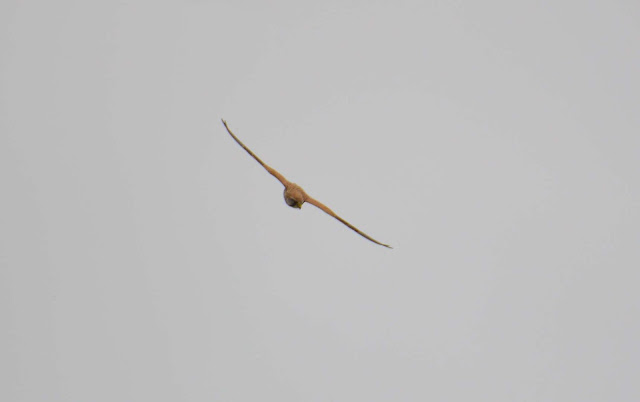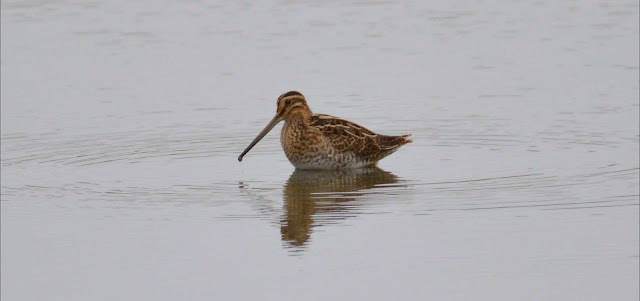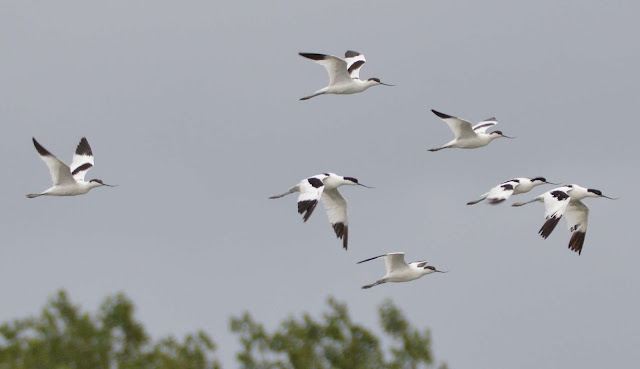So here we were again, gluttons for punishment. Back to Fishlake Meadows in Romsey. Surely an Osprey would put in appearance this time?
I met Chris early doors and our first sightings were of a couple of the many Grey Herons a few of them were juveniles. For some strange reason they thought it would be good to perch at the top of one of the dead trees whilst looking for a meal. Maybe they had been watching the kingfishers here and were taking a leaf out of their book of fishing techniques? But at 40 feet up it was a bit of a tricky one.
There was an occasional kingfisher zipping around below but it was so distant all I could get was a flash of the electric blue.
Then our first sighting of raptors. ..
Chris spotted a Hobby hunting at the back of the lake.
It perched very distant and even with a telephoto lens it wasn't great.
It was hunting dragonflies which is a staple diet along with hirundines.
The Great Crested Grebes had nothing to fear however. ..
We decided to walk north down by the canal to try and get a closer view.
We managed that, but only just.
There were at least 3 around. Clearly a family group. They breed here in the summer.
Search as we did the Ospreys continued to elude us. Time was nearing lunch and the forecast of rain was becoming reality.
Our option for the afternoon was to hole up in the many hides at Titchfield Haven nature reserve. So off we went happy with sightings of the beautiful Hobbys but a little miffed the objective was missed again. It will happen, I know that it will , well that is my fervent hope!
Thirty minutes later we were sat by the sea wall eating our lunch opposite the reserve which borders the Solent.
Next stop was the visitor centre to sign in and look at the notice board for bird sightings before entering the reserve itself from the west side.
The Meon river cuts a swathe through the centre of the reserve before spilling it's freshwater contents into the waters separating the mainland from the Isle of Wight.
The west side consists of scrapes or small freshwater shallow lakes that are ideal for a myriad of bird species to feed and breed.
The breeding season had all but finished. A month earlier and it would be impossible to hear yourself think due to the cacophony of noise from the Black Headed Gulls that nest here in their hundreds.
As we crunched over the stones to the metal entrance gate a calling Whimbrel circled above our heads. Similar to the Curlew but a little smaller. They are just passing migrants unlike the aforementioned bird.
The Meon Shore hide is the first to emerge past the reed beds that border either side of the path so we popped inside.
The south scrape was full of waders and ducks. Black tailed Godwits were here in numbers as usual. They don't breed here. What we see are either non breeding birds or ones on migration.
Their feeding technique consists of a few deep water probes then flicking of the bill into the air to consume whatever it has detected.
On the posts Common Terns fresh from breeding either sat or flew around squawking loudly at their youngsters.
The rain was now steadily falling.
At the back of the scrape a cormorant had caught an eel and was trying its best to eat it. The eel had other ideas and pulled all manner of contortions to deter being consumed. I caught an eel when I was a kid and I can tell you they are impossible to hold. More slippery than a snake smothered in butter . A waiting Grey Heron stood by in the hope of poaching it..
It managed to consume it eventually but I did think what it must feel like to have that wriggling around in the stomach for a while afterwards. I wonder how long it takes to die?!
There were many ducklings still around. These are Gadwall.
The common terns still made their points known to the young. Maybe saying it's time to move on South?
This is the time for migration. Common Sandpipers are frequently seen at this time. Feeding up after a long journey.
Just above the Sandpiper a Kestrel was hovering for a meal. It thought the Sandpiper was a viable meal and took a dive. ...
It flew away without luck. The Sandpiper flew away feeling completely the opposite.
Just in front of the hide there were rustlings in the reeds. Reed warbler fledglings were flitting in and out waiting for the parents to arrive with food.
Redshank are probably one of the most common waders here. Their shrill peeping call is often heard as they fly.
Snipe are numerous too except they are masters of disguise. Normally keeping to and into the vegetation by the side of the water, to see one out in the open feeding gives you a great opportunity to photograph them.
Their long bill is used like a little jackhammer. Short bursts of rapid drilling until a tasty morsel is located.
Their feeding location is in shallower water to that of the Godwits. Something Chris Packham is heard often to mention as niche separation.
Attention was back with the Godwits.
These three characters gave us some wonderful views as we studied them roosting and preening.
I constantly remind myself how lucky I am to be able to see these beautiful elegant waders and just 5 minutes from our home.
We could here a familiar pinging call from the reeds. We knew exactly what they were and we knew we might not see them at all.
Luck was on our side for once when Chris spotted two juvenile Bearded Tits. They are not members of the tit family. They hold a niche all to themselves. They should be called Reedlings. Either way they are little golden gems and a rare sight.
The rain had eased. Time to move to the Pumfrett hide just north that lyes in the middle of the first two scrapes. We left the Godwits and Reed Warblers plus a passing Stock Dove and walked the gravel path.
Not long after we entered the empty hide the Avocets performed an aerial display. Cementing their claim as possibly the prettiest wader, ne bird, to inhabit the earth.
Their breeding season virtually over, Hirundines gathered in numbers and did their utmost to gather all the airborne insects available in front of us.
All three that breed in the UK were here. Swallow, House Martin and Sand Martin. Swifts were here also but they are not classed as hirundines.
Swallow. ..
Young Herons have fledged and boosted their numbers considerably.
The Common Sandpipers were roosting and keeping a low profile in case some hungry unruly Kestrel payed them a visit.
The Hirundines kept flowing.
More Swallow. ..
House Martin
and Sand Martin...
We had exhausted the West side and the East side now beckoned.
As time was short, the Meadow Hide was our port of call. The Knights Bank hide was closed and the Suffern hide is usually quiet except for a distant Kingfisher and I'd had my fill of that for one day!
Immediately upon our arrival a bird of prey was gliding low over the meadow grasping an unfortunate Swallow. The classic flight pattern of a Sparrowhawk. ..
The local family of Kestrels took umbrage and intercepted the interloper.
The Sparrowhawk escaped with its meal while the Kestrels - 3 all told- either sat or flew between posts interspersed with a hunting foray.
Another successful family group like the Hobbys at Romsey.
So we ended the day as we had begun. Watching a successful family of raptors hunting. Next time it will be an Osprey. Stop laughing at the back please!
The title of this post is a lyric taken from the song 'We are Family' by Sister Sledge
I met Chris early doors and our first sightings were of a couple of the many Grey Herons a few of them were juveniles. For some strange reason they thought it would be good to perch at the top of one of the dead trees whilst looking for a meal. Maybe they had been watching the kingfishers here and were taking a leaf out of their book of fishing techniques? But at 40 feet up it was a bit of a tricky one.
There was an occasional kingfisher zipping around below but it was so distant all I could get was a flash of the electric blue.
Then our first sighting of raptors. ..
Chris spotted a Hobby hunting at the back of the lake.
It perched very distant and even with a telephoto lens it wasn't great.
It was hunting dragonflies which is a staple diet along with hirundines.
The Great Crested Grebes had nothing to fear however. ..
We decided to walk north down by the canal to try and get a closer view.
We managed that, but only just.
There were at least 3 around. Clearly a family group. They breed here in the summer.
Search as we did the Ospreys continued to elude us. Time was nearing lunch and the forecast of rain was becoming reality.
Our option for the afternoon was to hole up in the many hides at Titchfield Haven nature reserve. So off we went happy with sightings of the beautiful Hobbys but a little miffed the objective was missed again. It will happen, I know that it will , well that is my fervent hope!
Thirty minutes later we were sat by the sea wall eating our lunch opposite the reserve which borders the Solent.
Next stop was the visitor centre to sign in and look at the notice board for bird sightings before entering the reserve itself from the west side.
The Meon river cuts a swathe through the centre of the reserve before spilling it's freshwater contents into the waters separating the mainland from the Isle of Wight.
The west side consists of scrapes or small freshwater shallow lakes that are ideal for a myriad of bird species to feed and breed.
The breeding season had all but finished. A month earlier and it would be impossible to hear yourself think due to the cacophony of noise from the Black Headed Gulls that nest here in their hundreds.
As we crunched over the stones to the metal entrance gate a calling Whimbrel circled above our heads. Similar to the Curlew but a little smaller. They are just passing migrants unlike the aforementioned bird.
The Meon Shore hide is the first to emerge past the reed beds that border either side of the path so we popped inside.
The south scrape was full of waders and ducks. Black tailed Godwits were here in numbers as usual. They don't breed here. What we see are either non breeding birds or ones on migration.
On the posts Common Terns fresh from breeding either sat or flew around squawking loudly at their youngsters.
The rain was now steadily falling.
At the back of the scrape a cormorant had caught an eel and was trying its best to eat it. The eel had other ideas and pulled all manner of contortions to deter being consumed. I caught an eel when I was a kid and I can tell you they are impossible to hold. More slippery than a snake smothered in butter . A waiting Grey Heron stood by in the hope of poaching it..
It managed to consume it eventually but I did think what it must feel like to have that wriggling around in the stomach for a while afterwards. I wonder how long it takes to die?!
There were many ducklings still around. These are Gadwall.
The common terns still made their points known to the young. Maybe saying it's time to move on South?
This is the time for migration. Common Sandpipers are frequently seen at this time. Feeding up after a long journey.
Just above the Sandpiper a Kestrel was hovering for a meal. It thought the Sandpiper was a viable meal and took a dive. ...
It flew away without luck. The Sandpiper flew away feeling completely the opposite.
Just in front of the hide there were rustlings in the reeds. Reed warbler fledglings were flitting in and out waiting for the parents to arrive with food.
Redshank are probably one of the most common waders here. Their shrill peeping call is often heard as they fly.
Snipe are numerous too except they are masters of disguise. Normally keeping to and into the vegetation by the side of the water, to see one out in the open feeding gives you a great opportunity to photograph them.
Their long bill is used like a little jackhammer. Short bursts of rapid drilling until a tasty morsel is located.
Their feeding location is in shallower water to that of the Godwits. Something Chris Packham is heard often to mention as niche separation.
Attention was back with the Godwits.
These three characters gave us some wonderful views as we studied them roosting and preening.
I constantly remind myself how lucky I am to be able to see these beautiful elegant waders and just 5 minutes from our home.
We could here a familiar pinging call from the reeds. We knew exactly what they were and we knew we might not see them at all.
Luck was on our side for once when Chris spotted two juvenile Bearded Tits. They are not members of the tit family. They hold a niche all to themselves. They should be called Reedlings. Either way they are little golden gems and a rare sight.
The rain had eased. Time to move to the Pumfrett hide just north that lyes in the middle of the first two scrapes. We left the Godwits and Reed Warblers plus a passing Stock Dove and walked the gravel path.
Not long after we entered the empty hide the Avocets performed an aerial display. Cementing their claim as possibly the prettiest wader, ne bird, to inhabit the earth.
Their breeding season virtually over, Hirundines gathered in numbers and did their utmost to gather all the airborne insects available in front of us.
All three that breed in the UK were here. Swallow, House Martin and Sand Martin. Swifts were here also but they are not classed as hirundines.
Swallow. ..
Young Herons have fledged and boosted their numbers considerably.
The Common Sandpipers were roosting and keeping a low profile in case some hungry unruly Kestrel payed them a visit.
The Hirundines kept flowing.
More Swallow. ..
House Martin
and Sand Martin...
We had exhausted the West side and the East side now beckoned.
As time was short, the Meadow Hide was our port of call. The Knights Bank hide was closed and the Suffern hide is usually quiet except for a distant Kingfisher and I'd had my fill of that for one day!
Immediately upon our arrival a bird of prey was gliding low over the meadow grasping an unfortunate Swallow. The classic flight pattern of a Sparrowhawk. ..
The local family of Kestrels took umbrage and intercepted the interloper.
The Sparrowhawk escaped with its meal while the Kestrels - 3 all told- either sat or flew between posts interspersed with a hunting foray.
Another successful family group like the Hobbys at Romsey.
So we ended the day as we had begun. Watching a successful family of raptors hunting. Next time it will be an Osprey. Stop laughing at the back please!
The title of this post is a lyric taken from the song 'We are Family' by Sister Sledge












































































No comments:
Post a Comment
Please leave me a message if you would like to do so.